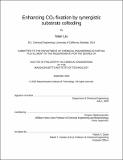| dc.contributor.advisor | Gregory Stephanopoulos. | en_US |
| dc.contributor.author | Liu, Nian,Ph. D.Massachusetts Institute of Technology. | en_US |
| dc.contributor.other | Massachusetts Institute of Technology. Department of Chemical Engineering. | en_US |
| dc.date.accessioned | 2021-01-05T23:13:00Z | |
| dc.date.available | 2021-01-05T23:13:00Z | |
| dc.date.copyright | 2020 | en_US |
| dc.date.issued | 2020 | en_US |
| dc.identifier.uri | https://hdl.handle.net/1721.1/129014 | |
| dc.description | Thesis: Ph. D., Massachusetts Institute of Technology, Department of Chemical Engineering, September, 2020 | en_US |
| dc.description | Cataloged from student-submitted PDF of thesis. | en_US |
| dc.description | Includes bibliographical references. | en_US |
| dc.description.abstract | The irrevocable rise of atmospheric CO₂ levels has prompted the development of scalable carbon fixation technologies in recent years. To this end, biological non-photosynthetic methods serve as promising leads since they not only sequester CO₂, but also convert it into a variety of value-added fuels, chemicals, and pharmaceuticals with high specificity. Additionally, as the organisms responsible for fixing CO₂ derive energy from free electrons or electron carriers such as H₂, the process can interface with existing photovoltaics to achieve a high energy efficiency (~8%) that outcompetes photosynthetic systems (<1%). In this thesis, we describe a non-photosynthetic CO₂-fixation approach that sequentially utilizes an acetogenic bacterium and an oleaginous yeast to accomplish the conversion of H₂/CO₂ into lipid-based biodiesel with acetate as the key intermediate. | en_US |
| dc.description.abstract | Despite its feasibility, this two-stage system suffers from slow metabolism of the two chosen microbes. To remedy the issue, we began by identifying the limiting factors, which was determined to be insufficient ATP availability for CO₂ fixation in the first stage and inadequate NADPH levels for acetate-driven lipogenesis in the second stage. Correspondingly, a dual carbon source cofeeding scheme was developed to promote mixed substrate metabolism in the two organisms, synergistically stimulating CO₂ reduction into products. We demonstrate that minor amounts of glucose addition to acetogen cultures saturated with H₂ enhances net CO₂ conversion into acetate by simultaneously satisfying ATP and e⁻ demands at the appropriate ratio. Similarly, feeding the resulting acetate in conjunction with small quantities of gluconate balances the supply of carbon, ATP, and NADPH, which significantly accelerates lipid formation. | en_US |
| dc.description.abstract | The work advances our understanding of systems-level control of metabolism and can be applied to many other situations as an alternative tool for enhancing strain performance in metabolic engineering. Many products other than biofuels can also be synthesized from CO₂ using the two-stage non-photosynthetic design as long as proper organisms are employed. As such, in order to expand the utility of the process, we also developed a data-driven host selection framework. By implementing a recommender system algorithm on strain-product-titer information collected from literature, we aimed to systematically summarize the criteria used for choosing an organism given a certain product of interest and vice versa. The results revealed an implicit principle that governs the selection of model versus non-model host organisms, which could benefit many industrial biotechnological applications. | en_US |
| dc.description.statementofresponsibility | by Nian Liu. | en_US |
| dc.format.extent | 212 pages | en_US |
| dc.language.iso | eng | en_US |
| dc.publisher | Massachusetts Institute of Technology | en_US |
| dc.rights | MIT theses may be protected by copyright. Please reuse MIT thesis content according to the MIT Libraries Permissions Policy, which is available through the URL provided. | en_US |
| dc.rights.uri | http://dspace.mit.edu/handle/1721.1/7582 | en_US |
| dc.subject | Chemical Engineering. | en_US |
| dc.title | Enhancing CO₂ fixation by synergistic substrate cofeeding | en_US |
| dc.title.alternative | Enhancing carbon dioxide fixation by synergistic substrate cofeeding | en_US |
| dc.type | Thesis | en_US |
| dc.description.degree | Ph. D. | en_US |
| dc.contributor.department | Massachusetts Institute of Technology. Department of Chemical Engineering | en_US |
| dc.identifier.oclc | 1227048902 | en_US |
| dc.description.collection | Ph.D. Massachusetts Institute of Technology, Department of Chemical Engineering | en_US |
| dspace.imported | 2021-01-05T23:12:59Z | en_US |
| mit.thesis.degree | Doctoral | en_US |
| mit.thesis.department | ChemEng | en_US |
